#until they were able to clone dolly the sheep
Note
Would it be possible to genetically code a baby to be identical to an irl person? Like in vitro gene fuckery to make a not-clone.
I am not 100% sure what this is asking, because to me "genetically code a baby to be identical to an irl person" implies.... a clone. Like, being 100% genetically identical to someone is a clone by definition.
Short answer for "real life science": cloning technology has come a long way since Dolly the sheep and genetic engineering in general is treated as an INCREDIBLY casual act by scientists working with model organisms, but genetic engineering of human genomes has a lot fo red tape around it and therefore a long way to go logistically. See: the CRISPR baby scandal (I'm not actually up to date on this, but thank you for the reminder that I want to be). This might be biased by my personal interests, but most of the chatter I've heard about full-organism cloning is related to conservation-- for example this cloned black-footed ferret.
My personal opinion on the direction of human cloning (based on observation of Western politics, interactions with biomedical research that's more on the "petri dish" side, and discussions with students of bioethics) is that I highly doubt we'll ever get to the point of making full-on clones (at least within the lives of anyone on tumblr), less due to technological restrictions, and more because of ethical complications. I do see a future where a person is able to order "clones" of specific types of tissues or even full organs for medical purposes. But I also want to emphasize that most of the basis on my opinion on this specific topic isn't, like, worth much more weight than the average reasonably informed person.
For more "wild fictional science" takes....
Yeah, I think fiction with even a vaguely near-future setting could have human cloning. Note than human cloning has this really annoying thing going on where the patterns of gene expression during development are like.... really wild. For example: genetic imprinting is an ongoing "problem." So I think near-future "steal person's hair, churn out clone" is probably out, but "I commissioned a clone of myself, donating whatever cells the lab needed" is in.
If you mean "could I gene edit my own embryo to look like Justin Bieber and musically talented, even if it's not a real genetic clone of him," then. Hmm. I think our understanding of the human genotype-to-phenotype pipeline is good enough that you could give your local mad scientist a list of traits and they'd be able to go, "okay, I will put in blonde hair here..." Buuuuut here are the problems I would anticipate (besides being thrown in jail if caught):
Doing more than one gene edit at a time results in like. Problems? Idk, my ex-lab did some CRIPSR and we were phenomenally bad at it (and also, I never designed anything myself, just injected CRISPR juices; please do not ask follow up questions LMAO). It was a lot of "try on like thirty embryos, let them get to adulthood and only five survive because we jammed a needle full of chemicals into a single-cell embryo, oh fuck it only worked in one," which is both ethically and logistically iffy with humans. So I think with current technology, this would be. Stupidly risky to try the hundreds of edits you'd need for a Bieber clone. But I can see minor gene editing and screening of human embryos as a vaguely near-future advancement. TBH I think "full genetic clone of Justin Bieber" is probably easier than "tweak someone else's genome until they look like him."
I don't think our understanding of genotype --> phenotype is like.... as nuanced as people pretend it is. I think you could reasonably predict some things, but I don't think you'd get a lot of.... idk, detail? From our current understanding of genetics, and for humans specifically, I think some traits are so complex in terms of the interaction between environment, genetics, epigenetics, culture, and just, like, personality, that you wouldn't even replicate all of them with a perfect genetic clone.
But also, if this is a wild scifi fake scenario.... sure? I think environmental factors would prevent you from getting an exact clone, but you could get something...... close.
13 notes
·
View notes
Text
i have been doing an awful lot of thinking about dani and vlad’s attempts to clone danny and it’s been giving me headaches for various reasons, so here are some thoughts

i have been mulling over the fact that dani was stabilised by using the ecto-dejecto, which increases a ghost’s strength and apparently has worked infinitely for her since application and there is just... so much to unpack here
for my own sanity’s sake i will start by focusing on her ghost half, though we don’t actually know how ghost dna works, for all that we know, hell we don’t understand everything abt dna as it is - “genetic structure infused with ecto-plasm” is not as helpful as canon thinks it is!
on a very basic level this could mean exactly what it sounds like at face value, which might even explain why the ecto-dejecto only needed to be applied once, bc ecto-plasm doesn’t seem to shift states easily once it’s stable
i already hate how much this breaks reality, because look, we’re like mouse in matrix rn explaining to neo that the machines don’t know what tastee wheat actually tastes like and the sludge pudding they’re eating may be actually the taste of cornflakes but nobody knows bc the machines botched the job AND MAYBE THAT’S WHY SO MANY THINGS TASTE LIKE CHICKEN
like we can base ghost dna off of our dna, we can say that despite being coated in ecto-plasm it works like regular human dna as long as the halfas are in their human form, but none of this is real so we already don’t know
so maybe canon worked out for once
but maybe also ecto-plasm is its own genetic material on a technicality effectively making danny, vlad & dani chimeras and at this point we can throw my previous statements out of the window again and have to define how ecto-plasm works on a genetic level and how it works together with human dna
which is a level of pandora’s box i will not get into today, but basically what i am saying is that dani might actually still have unstable ghost powers and needs regular shots to stabilise her, but how would she even do that without the ecto-decjecto? does she eat ecto-plasm her fellow ghosts? does she get cravings for the green goop? is there human food that allows her body to self-regulate so she gets other cravings? is there a type of medication she could take? is she actually the cannibalistic vampire plasmius could have been?
okay, okay, let’s just leave that for whatever it is right now and look at her human half
dani’s human half was never stabilised
did it need to be? look, i’m no expert in genetics just really enthusiastic, but when she was dissolving it didn’t look like she was just shedding her ghost half but her entire body was going goopy so i’d say she was at risk as an entire being so yeah her human half should have required some stabilisation too
our dna is actually not something that’s set in stone, it’s quite unstable tbh, but it also has a ton of ways to repair itself entirely unprompted by outside influences, so technically we could say that since she was the only sapient clone it’s safe to say her human body is generally stable enough to deal with normal ranges of dna machine broke
however she has ecto-plasm in there! whatever the heck it is now, it’s in there! and she was melting!
so i am going out on a limb here and say that anything that destablises her ghost half automatically destablises her human half, the basic principle of this actually works on regular dna
if the her human dna is generally unstable there are really only two ways this can go and both are bad and i am going to deal with neither bc they would completely hijack any other plot that may been previously present in your fic
but then there is also the matter of her being a clone in the first place
how much research went into that, it’s not like there are cloning for dummies books
how many theoretical degrees does vlad have, is his scientific field just “yes.” bc it’s all of them??
genetics, bio-engineering, micro-biology, neuroscience and some form of medical degree is some of the stuff that comes to mind for me
ghost lore & biology are not real degrees but i’m pretty sure vlad has whatever it takes to get them
when dani first shows up she is said to be a 12 yrs old biologically and a couple months chronolically, which tells us a lot actually
cloning dolly the sheep took over 200 tries, so it’s fair to say that vlad ended up with a whole lot of experiements that failed shortly after conception and that he managed to get three living clones before dani was even a thing is immensely impressive
it also tells us that he was able to speed up the ageing process/development of their growth through means unknown to us
however, i do not believe that any amount of accellerated cell growth gave dani knowledge
hear me out for a moment, it’s very likely that dani actually had the brain chemistry of a 12 yo when she woke up, and having that would have given her a number of advantages over baby clones
that gives her an incredibly good base level for processing the world around her, taking up new information and assessing it, as well as being able to clearly “voice” (and i use that word loosely here) her likes and dislikes, 12 is also a very good age for molding a brain, especially when it’s empty, very impressionable age still
but that’s it
i don’t believe she popped out of that tank ready to take on the world with a plethora of knowledge bc vlad injected it into her brain matrix style, we don’t know enough abt the brain yet to do that and even if we could, we couldn’t do it at that speed and time is something vlad does not have when it comes to cloning, it’s not like baking a cake, he wouldn’t have been pressing a button and popping clones out of tanks like they’re muffins!
i will fight anyone who tries to tell me dani knew what a fork or a goddamn toaster was when she met danny (ok no i actually imagine vlad taught her table manners but you get the gist)
for a long time, probably the entire span of the rest of the show since her creation and first meeting danny, anything she did, she would have done for the first time in her entire life 9/10
being 12 and being able to speak would actually cover most of the gaps for her, but her speech would have likely included a lot of “this” and “that” and “there” and her behaviour would have been mimicking people more than often not to stand out, and she probably would have parroted people for a while to learn new words (i think she keeps a notebook full of things new to her)
so i believe those few months after her creation before she was sent after danny, vlad finally got to take a shower and shave and dress nice again, while suffering severe caffeine withdrawal for a couple days, and he’d just teach her stuff
a few months isn’t enough to cover everything, but just enough if he’d done nothing but that
it would have gotten dani familiar with basic things like walking, using words properly, and flying, just as much as what a fork is, table manners but also how cars and electronics work and what she was supposed to expect from the outside world, and since she was the first one who was self-aware vlad would have doted on her, if only bc he’s proud of his achievement
it would also explain why dani was willing to trust him blindly up until the last moment, or why she calls him “dad”
dani’s ghost half being primarily strengthened might explain why she primarily lives as a ghost bc it could simply be more comfortable for her when it comes to states of being, but it could also be because the ghost world is less judgey when it comes to her lack of experience in being alive
i mean?? they’re ghosts?? many of them died prematurely and would have missed out on so many things they otherwise would have gotten to experience? i bet dani just feels more at home when she’s with them, more like she belongs
this is neither here nor there, but i believe she and danny have some level of shared empathy, it’s not like luke and nell from haunting of hill house, just enough to easily read each other
#fandom: danny phantom#character: danielle fenton#character: vlad masters#type: text post#type: gif#danny phantom#danielle fenton#dani fenton#vlad masters#vlad plasmius#i couldn't actually find out how long it took#until they were able to clone dolly the sheep#but i doubt science can just crank out#200+ possible baby sheep#in like#two weeks#so i reckon it took at least several months#but probably more than that#which means that vlad speedran cloning#sdkjsdfksslkg#vlad is like#like that one math guy#who had a bet going w one of his friends not to do drugs for a month#bc he used them to sleep less and do more math#and like he made it!#but his comment was like#sure but now mathematics has been set back by a month#vlad whenever he has to stop doing science like a madman#science just has been set back by a month#which field?
36 notes
·
View notes
Text
TAFAKKUR: Part 243
FROM GENES TO PROTEINS: A NEW LEVEL OF COMPLEXITY: Part 1
Newspapers frequently run articles reporting a study about a gene linked to some disease. Thanks to such wide media coverage, the word "gene" has become a household term for most of us. And, genetics, the study of genes, probably owes its popularity to a female sheep you are all familiar with: yes, I mean Dolly, the first animal successfully cloned from an adult body cell.
We inherit our hereditary characteristics from our parents. The basic unit responsible for inheritance in our body is the gene. More technically, a gene is a hereditary unit consisting of a sequence of DNA that occupies a specific location on a chromosome and determines a particular characteristic in an organism. Genes are like words on the long string of DNA. The description of the fundamental process of synthesizing proteins from the information on genes is called the "Central Dogma." According to this dogma, DNA is used to synthesize RNA, and in turn, RNA is used to synthesize proteins. Hence, this dogma dictates the link between genes and proteins. Proteins are actually a translated and three-dimensional version of the linear information stored in genes.
THE STRUCTURE OF DNA
DNA (Deoxyribonucleic acid) is our repository of genetic information. Although there are organisms such as RNA viruses that possess RNA (ribonucleic acid) as their genetic material, virtually all other living organisms inherit their genes through DNA. Hence, DNA is vital for the existence and perpetuation of life on Earth.
In a simple comparison, DNA can be likened to a sequence of letters where each letter is a single nucleotide, and the alphabet has only four letters: A, T, C and G. Although this alphabet is extremely small compared to those used in human communication today, we are still capable of capturing the vast size of human DNA with this analogy: Our DNA is composed of a sequence of nearly 3 billion (3,000,000,000) of these letters. What this means is that, if you were to type out your genetic code, you would have a 5,000-volume encyclopedia, with each volume containing 400 pages, and each page having 1,500 letters! But then, how do we even fit this formidable size of information in every single cell of our body? The answer lies in the astonishing folding, packaging and wrapping steps DNA goes through upon synthesis. Positioning nucleotides side by side, each DNA molecule would take up about 6 feet (~2 meters) of space. However, after all the packaging steps, DNA becomes compact enough to fit in not only a cell, but also in the microscopic nucleus of each cell.
GENES AND THE HUMAN GENOME PROJECT
Unfortunate for our alphabet analogy above, the 3 billion nucleotides in DNA do not contain any spaces to let us know where each word begins and ends. The Human Genome Project accomplished the task of unraveling what these 3 billion letters are (each one is one of A,T,C and G) and this was a major achievement of humanity. However, it was not until then that we realized the real challenge DNA posed us: Where were the genes in DNA? In other words, how would we understand the words and sentences in this 3-billion string of letters? Apart from efforts to discover the DNA sequences of other organisms, it is not unfair to say that the interest and workforce once focused on the Human Genome Project has now almost completely shifted to this latter "real" challenge of discovering the genes in DNA.
How we wish life could be that easy! Just as completing the human DNA sequence made us realize that we did not know where the genes are, discovering some genes allowed us to understand that we would still be missing a major part of the picture even if we knew exactly where each gene was. Do we not frequently encounter instances in everyday life where one word means different things depending on context? So, is there any good reason to think that genes on our chromosomes will be any less complex? Unfortunately not. Quite to the contrary, the sense is growing that genes are actually far more complex and intricate than we originally thought. For one thing, a single gene may not cause an immediate effect, but may interact with a network of other genes to produce the final effect. Diseases that are caused by individual genes are actually very few, a famous example being cystic fibrosis. But diseases that are affected by the interaction of many genes are far more numerous and prevalent, for example, breast cancer, Alzheimer's disease, Type 1 diabetes mellitus, multiple sclerosis and obesity.
This latter group of diseases is appropriately called "complex diseases." Efforts are under way to decipher the intricate genetic and protein networks responsible for such diseases; however, there are so many (known and also unknown) variables that biologists have already called for help. Research problems such as complex diseases that require the interaction of biologists, mathematicians, computer scientists and statisticians alike have led to the advent of the currently very popular field of "Systems Biology." Viewing the cell as a large factory, this field aims to understand all molecular networks and interactions that make up the very sophisticated machinery in living systems. After deciphering how cells operate flawlessly as a complex system, humans will be better able to discover causes of diseases, and will also be in a much better position to manipulate cells to cure diseases.
The idea of manipulating cells and cell components such as genes and proteins has actually led to "Synthetic Biology," which is, in essence, the engineering approach to Systems Biology. Synthetic biologists try to engineer gene and protein networks in the cellular machinery to program cells for synthesizing custom-tailored molecules. This can be in the form of redesigning or producing mass amounts of existing molecules, or synthesizing nonexistent molecules that have medical or other potential uses. The overall significance of the field can be well understood by the following quote from one of the pioneers of the field, UC Berkeley professor Jay Keasling: "(Synthetic biology is) doing for biology what electrical engineering did for physics and what chemical engineering has done for chemistry."
One example of synthetic biology comes from Jay Keasling's lab. In collaboration with the Gates Foundation and OneWorld Health, the first nonprofit pharmaceutical in the US, Dr. Keasling's lab is engineering a new metabolic pathway in E.coli to produce the precursor to artemisinin, currently the most effective treatment for malaria. The prospects include a drastic drop in cost, from dollars to dimes. Moreover, success in redesigning a metabolic pathway in bacteria holds great promise for reproducibility for other similar pathways important for the pharmaceutical, cosmetics and food industries.
#allah#god#prophet#Muhammad#quran#ayah#islam#muslim#muslimah#hijab#help#revert#convert#religion#reminder#hadith#sunnah#dua#salah#pray#prayer#welcome to islam#how to convert to islam#new convert#new revert#new muslim#revert help#convert help#islam help#muslim help
1 note
·
View note
Note
Hi, could you please explain that chinese research with the crispr genes like I'm 5? It strikes me as something very serious, but I understand absolutely nothing about it
short answer: imagine that since like 1930 we’ve had a machine that has some chance of generating either an incredible ultrahuman that never catches any diseases, or a horrible mutant that will live in pain for the entirety of its brief life. so for the past almost century we’ve all dutifully been like “no, we’re not using the monster generator,” and every year we have several science conferences to discuss whether we should push the monster button, and every year the experts of the field are like “that’s still a no from me.”
except this year some guy (chinese researcher he jiankui) was suddenly like “hello, actually, i’ve already pressed it seven times. six of them died. rip.”
(note: crispr is not 90 years old, but our awareness of the structure of DNA is. also, i should mention that the claims haven’t been substantiated, but i’m going to write this under the assumption that he wasn’t just telling lies.)
better answer from someone else (link)
long answer:
idk if you’d remember this, but one of the hot-button issues during george w bush’s presidency was stem cell research, and when i say “hot-button issue” i mean like, the pope at the time got personally involved and made several different statements specifically opposing it. stem cell research got summarily banned, and as far as i know it still is in most countries.
stem cells & crispr gene editing are not the same thing, but they might fall under the same ban in some jurisdictions. animal genetics research is sometimes allowed in some places, but human trials have literally up until this very moment in history been considered unconscionable, if not explicitly banned by most countries.
leading up to the stem cell debate (circa 80s-00s?) there was also a lot of hoohah in the press about cloned animals (dolly the sheep, et al). all of this stuff just sort of suddenly disappeared from the headlines when stem cell research was banned, and genetics basically left the public consciousness for a hot minute until GMOs came along. here’s the key thing, i think: the question “What should we do with DNA?” has been on the collective mind pretty consistently, ever since crick & watson stole rosalind franklin’s research. the answer is usually “eugenics,” “capitalism,” or “nothing,” depending on whether you’re the worst kind of asshole or not, but there’s a surprising lack of people willing to risk their career for saying “what if we did something with DNA that wasn’t eugenics or capitalism?”
DNA is like the world’s most complex microscopic knot, and if you’ve ever tried to understand programming code written by somebody else, then try to imagine code written by nobody at all that just sort of appeared a billion years after some lightning struck a swamp – and that’s kind of what DNA is like.
so you go in with a microscope like “ah yes, here are the genes that make this human baby susceptible to HIV, let’s just turn those off,” but like… how do you know you are actually doing what you think you’re doing? how do you know it’s not going to make significant changes elsewhere? how do you know you didn’t just make them susceptible to some worse disease? how do you know they’re not going to have some never-before-seen and lethal birth defect? you don’t, because it’s never been done before, and anybody who isn’t as mad as a hatter generally considers it way too complex to even reasonably approach… making the assumption that you or anyone is capable of knowing enough about DNA to even touch it is so arrogant and hubristic it puts classical epic and myth to shame.
(this isn’t strictly speaking true, particularly as we build smarter computers, and i’d like to see a future that perhaps includes ethical gene therapies, but at the moment, most reasonable researchers stick to using cripsr for applications like making mosquitoes sterile to eliminate malaria – and even this is so controversial it has never been tried outside a research facility. even with the significantly reduced complexity within mosquitoes, we still don’t know whether it will work as planned, and no one has really been able to come to a consensus on whether it’s responsible to proceed when there are so many unknown risks on the table.)
so when this guy (he jiankui) got up at a genetics conference like “actually i’ve done it, and the seventh trial resulted in a successful pregnancy,”
like i don’t know what else i can say, this is clearly a watershed moment for better or worse and i can’t possibly imagine where we’re going from here. someone finally stepped forward and said “i’m going to try it and damn the consequences,” and while that’s not an admirable quality for a medical professional, it is definitely, i don’t know, bold?
there are some further nuances like, it’s not entirely clear whether the couples in the trial knew they were participating in a gene editing experiment (although they knew they were participating in an HIV treatment trial and one parent in each couple was HIV+), and not informing your patients what you’re doing to them is thankfully another huge no-no in the medical community
i don’t support or condone this but i am shocked and amazed by it
3 notes
·
View notes
Text
Days 126-127: Edinburgh, Part 2 (History, Hiking, and Beer)

Our last two days in Edinburgh marked the two-thirds point of our journey in Europe, and the halfway point of my dad's stay with us in Scotland. So far, all we'd really seen of the city itself was the castle, the Whisky Experience, and a few square blocks around the train station in New Town. There's far too much for us to try and see everything, so we picked out a few top choices and did our best to enjoy them as much as possible.

After saying hello to the neighborhood cat, we took the bus into town toward our first stop of the day--the National Museum of Scotland. Now that we'd figured out Edinburgh's bus system, it was actually pretty easy and convenient. And compared to underground metros, buses give you a much better sense of how a city fits together.

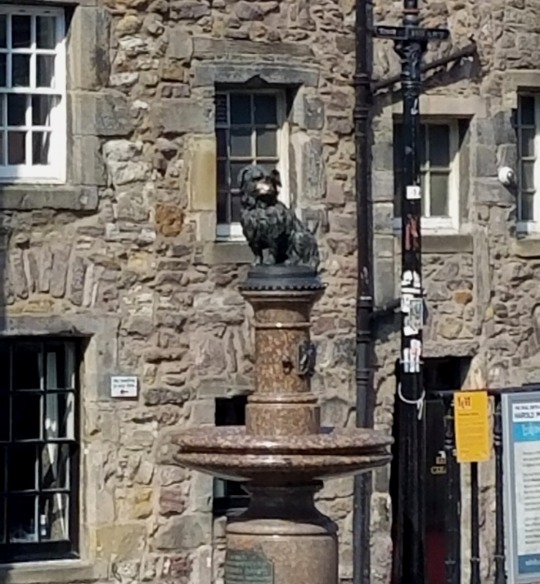
We got a closer look at the statue of Greyfriars Bobby, a legendary local terrier who faithfully guarded his master's grave for 14 years until his own death in 1872.
Passing Bobby by, we headed on toward the museum.
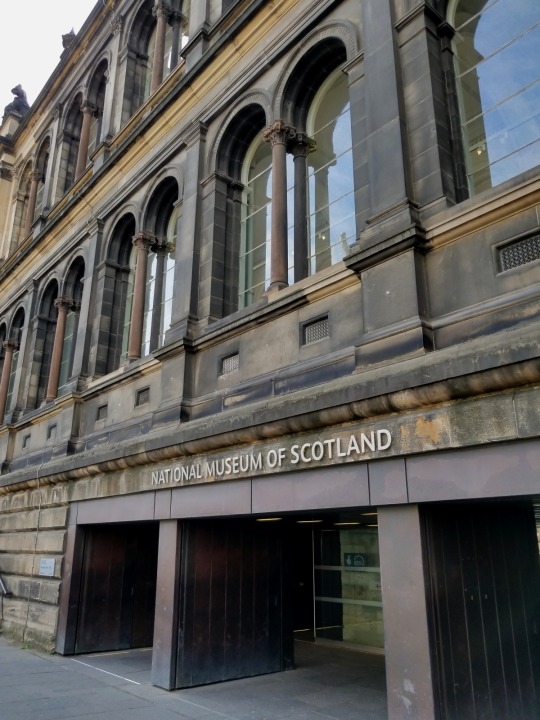
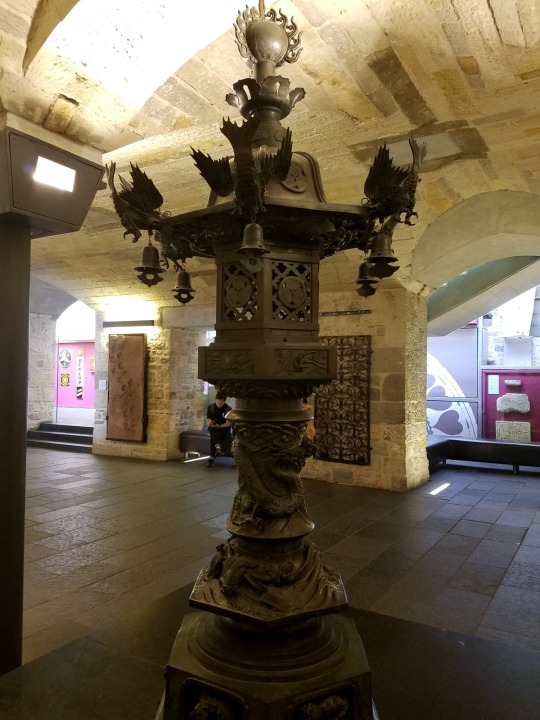
The ground floor entry hall had a diverse collection, including a 19th-century Japanese lantern presented on a precisely shin-high marble plinth. It's funny--when I ate it in the Rif Mountains of Morocco, tearing a hole in my pant leg and scraping up my knee, it healed up just fine after a few days. But when I banged my shin against that stone platform without leaving the slightest mark on my pant leg, it took off a chunk of skin underneath and left a deep scar that's still conspicuously purple six months later.
After killing some time in the gift shop--where I found a miniature Blackwatch-patterned umbrella to replace the much-bulkier one I'd been carrying--we joined up with a free tour that introduced us to the various sections of the museum.
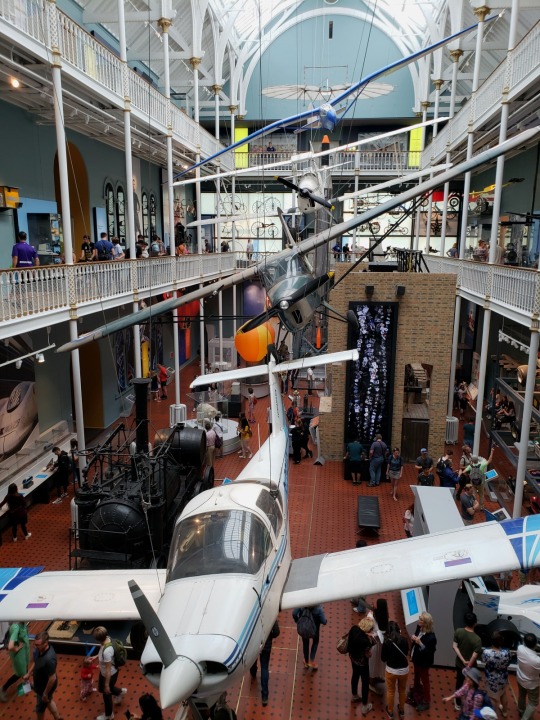
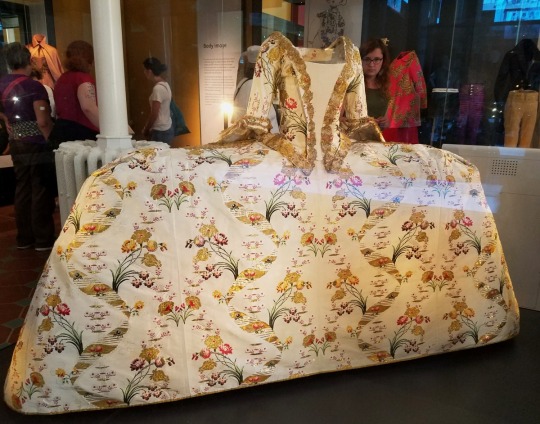

The Museum can be roughly divided into four sections: a Scottish history museum, a science and technology museum, a world cultures museum, and a natural history museum. It doesn’t compare to the British Museum in London, of course, but nothing can.
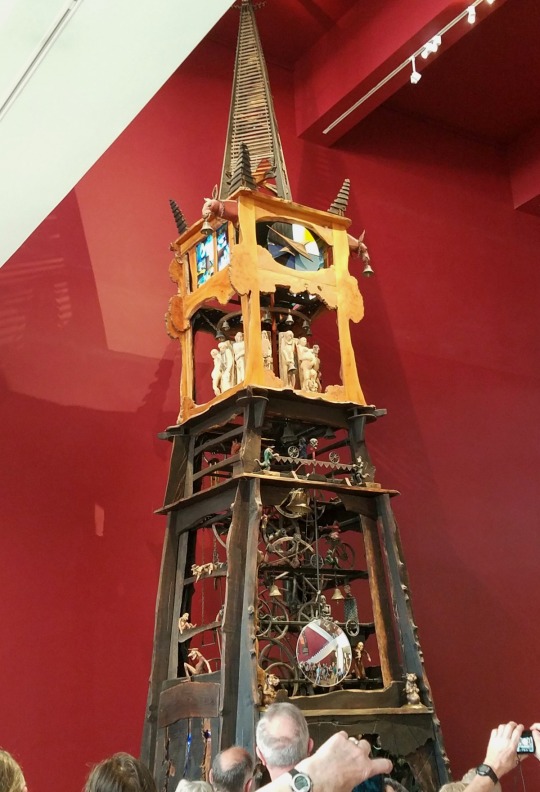
We saw a ridiculously complicated clock that our guide complained never works quite right.
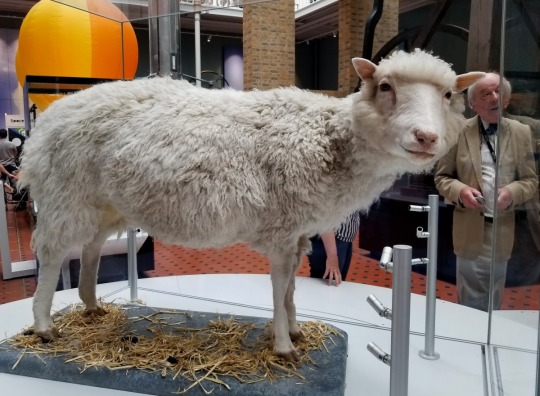
We also saw Dolly the Sheep, the first-ever successfully cloned mammal. Not a recreation--they actually stuffed her after she died and put her on display. We appreciated the attention to detail with regard to the sheep poop at her feet.
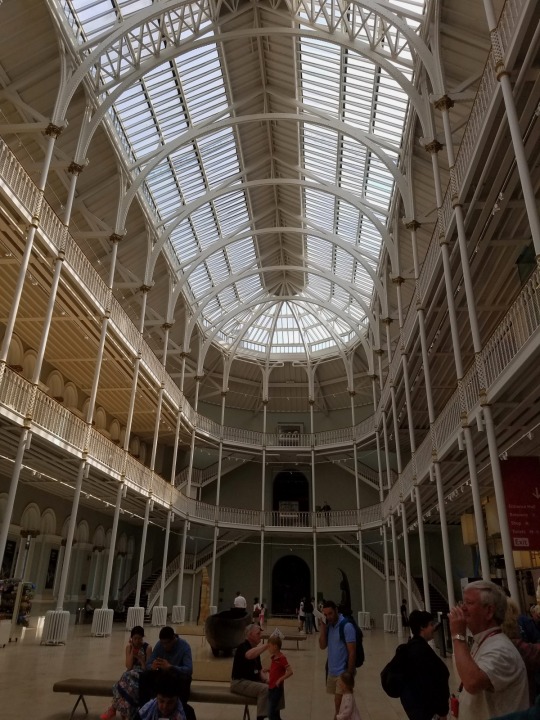
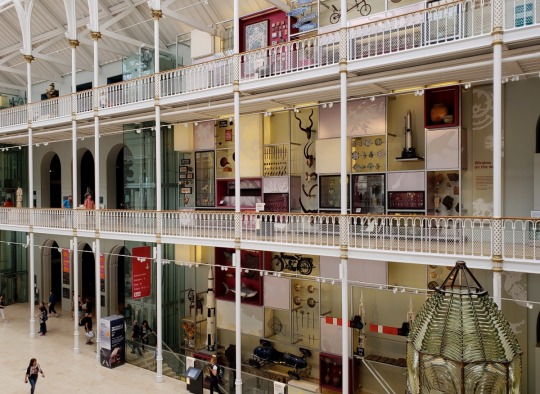
The museum is huge. At the center is a massive Victorian hall inspired by the Crystal Palace that used to stand in London. To us, it looked uncannily like the panopticon of Kilmainham Gaol in Dublin. Our guide was nice, but he was so soft-spoken that we could barely hear him most of the time. Once we felt sufficiently oriented, we broke off and went back to the exhibits we were most interested in.
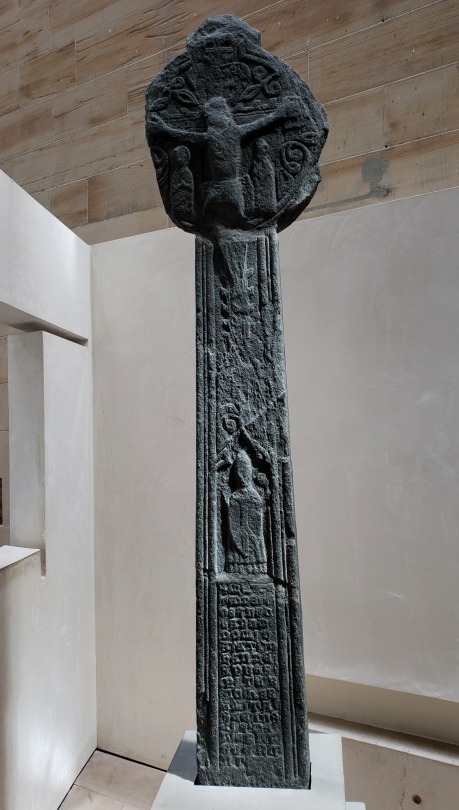
We spent most of our time in the Scottish history museum, which contains a very impressive (and well-displayed) collection of artifacts either made or found in Scotland, dating from prehistoric times up into the 21st century. Limited on time, we mainly stuck to the medieval history floor.

To either side of an old stone inscribed with Celtic knotwork, the walls bear a quote from the Declaration of Arbroath, a 14-century plea from the people of Scotland to Pope John XXII for support in their battle against the invading English army:
For we fight not for glory, nor riches, nor honours, but for Freedom alone, which no good man gives up except with his life. As long as only one hundred of us remain alive we will never on any conditions be brought under English rule.
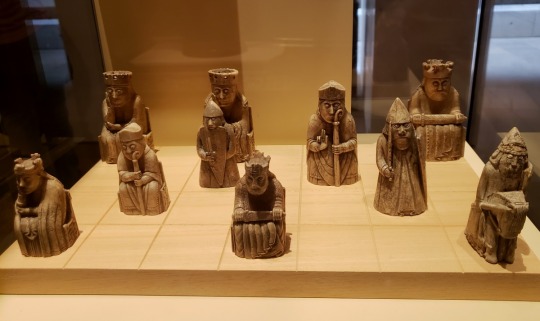
One of the highlights of the medieval collection are the Lewis Chessmen, part of a medieval Viking chess set discovered on the remote Scottish island of Lewis and Harris.


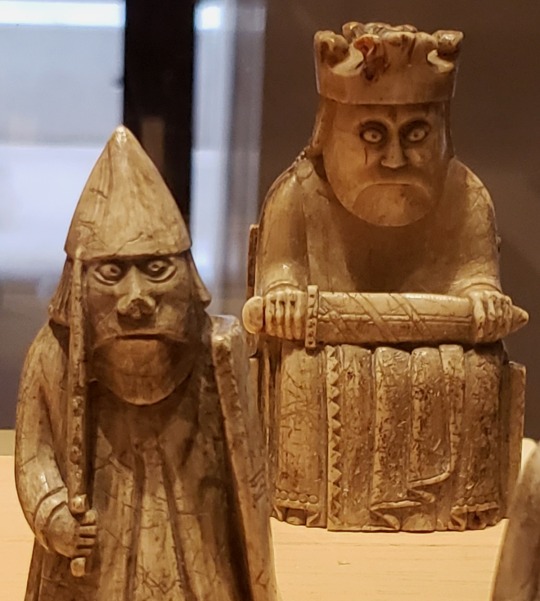
Eleven pieces of the set are here at the National Museum of Scotland, while the rest are in the British Museum in London. They are carved from walrus ivory and whale teeth with remarkable detail and emotiveness. They could be characters straight out of a modern animated Viking movie.
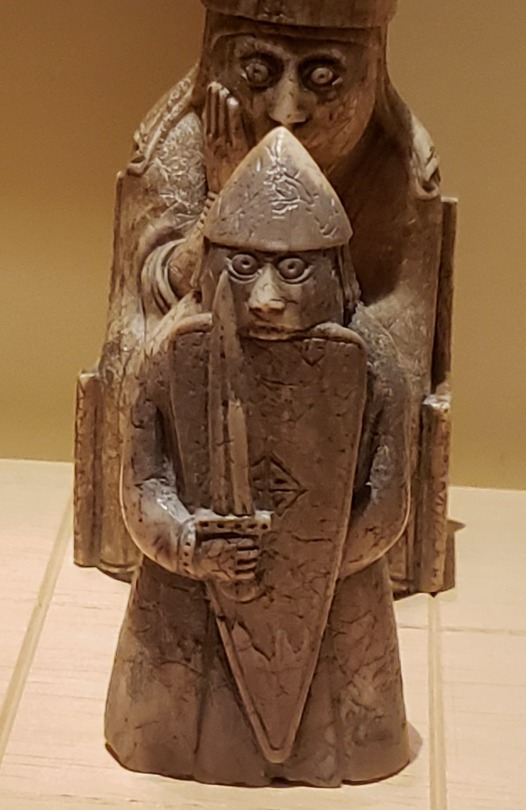
The rooks are depicted as berserkers chewing their own shields in battle frenzy.
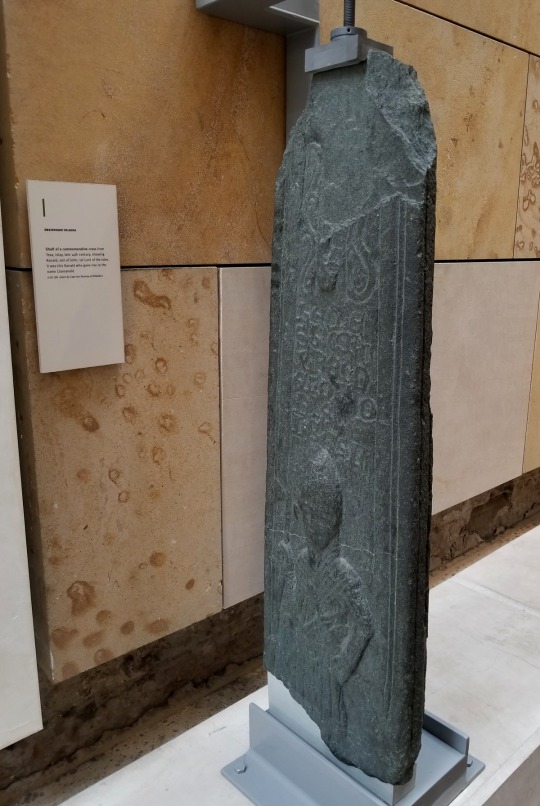
Nearby, we saw the remains of a Celtic cross from Islay, another Scottish island where we'd be staying next after Edinburgh.


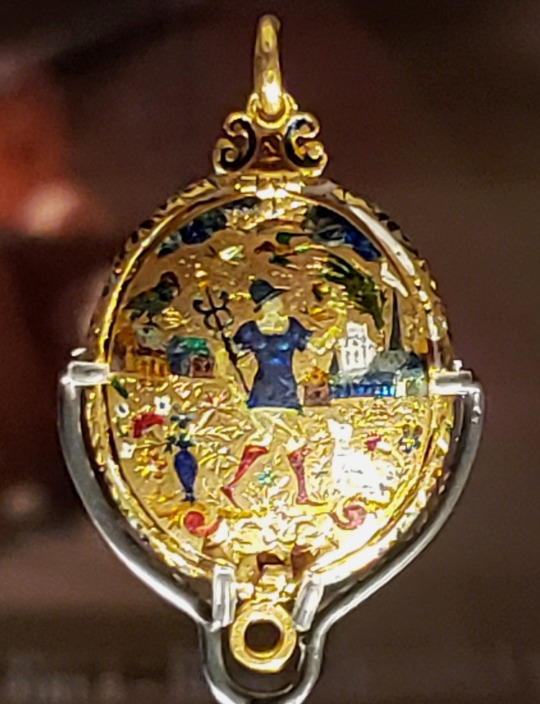


Some other highlights included a 17th-century Scottish flag said to have been carried in battle against Oliver Cromwell, a Celtic harp that may be the twin to the Brian Boru Harp at Dublin’s Trinity College, intricately detailed jewelry, some beautifully engraved early firearms, and a precursor to the guillotine known as “the Maiden”--gently used.

Upstairs, they have a good section on the Jacobite rebellions, when the ousted Stuart kings of England returned to their native Scotland to raise an army and reclaim the throne in London. It was a hopeless cause, and after three generations the rebellions finally died out.

Finally, we browsed through a section on the 1700s, when industries like textile weaving and coal mining were starting to boom like never before.
At the top of the museum, we discovered a fabulous view of the castle to the northwest and of the mountainous Salisbury Crags and Arthur's Seat to the east.


During one of our tours, our guide mentioned Arthur's Seat--a tall volcanic plug that overlooks the city--in a warning against taking online reviews at face value. Apparently, someone on TripAdvisor left a one-star review complaining that it was "just a hill."

The elevator was abominably slow--after spending a good while taking pictures on the roof, we returned to find people who had left the rooftop as we arrived still waiting for the elevator to make its next return. When it finally arrived, we weren't able to fit in, so we decided to make our way down the stairs instead. That may have been a mistake, though. The stairwells and back corridors were so maze-like that we literally caught ourselves going in circles before finding a room we recognized. It was like being back at the Lyon bus terminal.

After the National Museum, I headed off on my own to do some shopping in New Town. Second-guessing my decision to not buy shoes until after Islay, I wanted to see if I could find anything good in the last big English-speaking city we'd be staying in. I didn't find shoes, but I did get some spectacular views.


One of the most striking things about Old Town is it's verticality, which I've mentioned before. The old stone buildings seem to be scrambling up on each other's shoulders, reaching for the sky. We'd also learned from Nik the day before that this is part of an Edinburgh tradition that far predates them. Throughout the Middle Ages, when the city was mostly made of wood, the constricting city walls forced people to build up, creating towering wooden "skyscrapers" that frequently fell down or caught fire. They were crammed with people, and the ensuing sanitation issues were legendary across Europe. It got so bad that Edinburgh earned the nickname Old Reeky.

That was why, in the 1700s, the wealthier citizens finally decided to escape the city walls and build a spacious Georgian-style New Town to the north.


Down in the park where the castle moat used to be, people were crowding to see drum corps performing. August was still a couple weeks away, but the festival season atmosphere was alive and well.

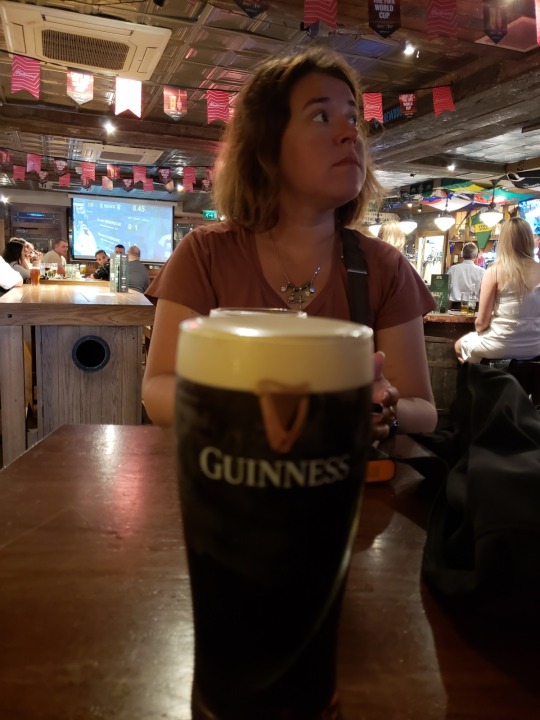
Meanwhile, Jessica and my dad searched out a pub where we could hole up and watch the final World Cup game between Croatia (who we were rooting for) and France. We’ve learned that Scottish people tend to have a great affinity for the French, if only because of their shared rivalry with the English. When the final whistle marked France's victory, the pub erupted in a celebration unlike anything I've ever seen in person.


Emerging back into the overcast sunlight, we cooled off with a relaxing walk down the breezy Royal Mile. We wanted to get some dinner at the famous World’s End pub, but it was full up. The pub's name dates back to a time when it butted against the old city walls. Anyone entering the city had to pay a steep toll to pass through the gates, even if they were residents. For many people, this meant that if they ever left the city, they might never be able to get back in. To them, this pub might as well have been the world's end.
We turned back and ended up enjoying a wonderful dinner at an Indian-Thai hybrid restaurant--once we were finally able to find the door.
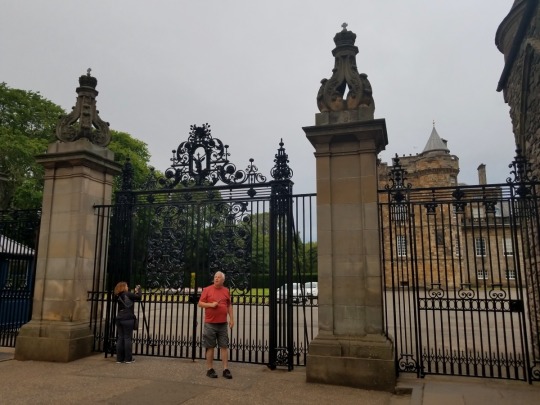


After dinner, we strolled the rest of the way down the Royal Mile to Holyroodhouse, Edinburgh's royal palace. It was well past closing time, but we were able to get a good view through the gates.

We also got to see the distinctive architectural style of the of the Scottish Parliament Building, and the Salisbury Crags jutting up dramatically behind them.

We'd be returning first thing tomorrow morning to hike the trail that runs beneath them. But for now, we ran to catch the bus that would take us back home. We tried to get my dad to watch the pilot episode of The Expanse, but we didn’t quite make it to the end before we were all starting to drift off.

The next morning, we bused back to Holyrood Palace and picked up where we left off--facing down the Salisbury Crags.
We--or at least I--didn't have the time or nerve to climb the larger Arthur's seat, but the Crags offered a nice compromise. And we didn't actually climb the top of the Crags. Rather, we followed the Radical Road that runs halfway up the Crags, along the foot of the cliff face.

The Radical Road is named for a group of workers that took part in a nationwide strike in 1820 known as the Radical War. Wealthy Scottish citizens like Sir Walter Scot who supported the Radicals decided to support them by paying them to do other work while they were on strike--such as building a completely unnecessary road midway up the Salisbury Crags and parallel to a perfectly serviceable road that already existed.



The beginning was steep, and my dad and I quickly started to question our decision, but all doubts were erased as we got high enough to see the view over the city.



At its height, the road cuts through Hollyrood Park, which used to be the private hunting grounds of the kings and queens of Scotland.
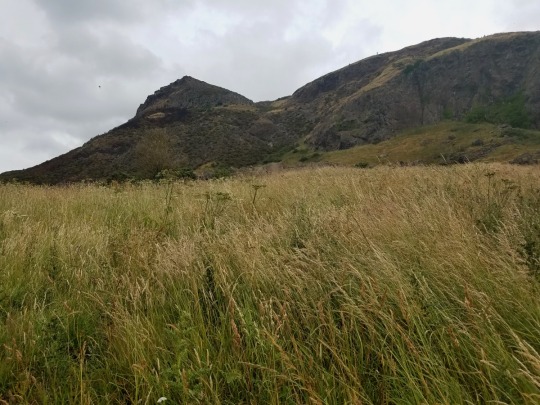


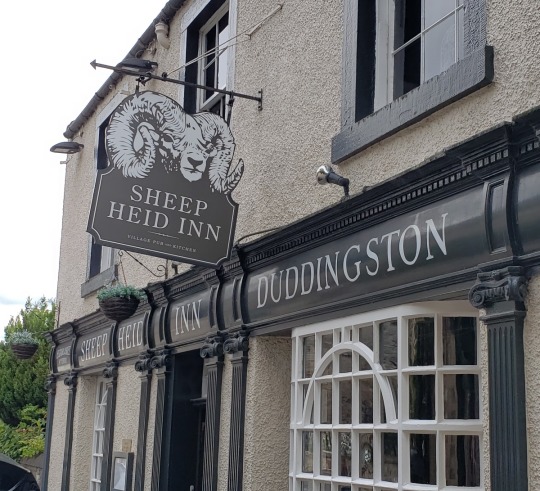
Reaching the end of the Radical Road, we kept on going toward the neighborhood of Duddingston and the highly-recommended Sheep Heid Inn. The inn has reputedly been in operation for over 600 years, which would make it the oldest pub in Edinburgh and possibly all of Scotland. The name comes from the old Scotts English for sheep’s head. The popular explanation is that King James VI of Scotland (and I of England) presented the pub owners with a golden snuff box engraved with a ram’s head on the lid. The pub was halfway between two royal residences, so James would often visit the pub along the way.
The kitchen wasn't quite open yet, so the three of us ordered drinks and enjoyed a rest after our hike. Once the kitchen opened, the food turned out to be just as spectacular as all the people who'd recommended it to us said. Jessica and I both had linguine with crab, shrimp, and chorizo. I don't even like seafood, but I loved that meal.
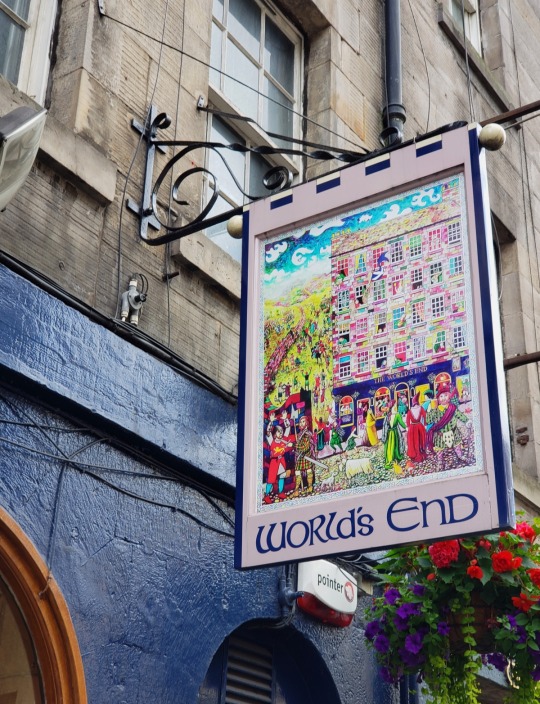
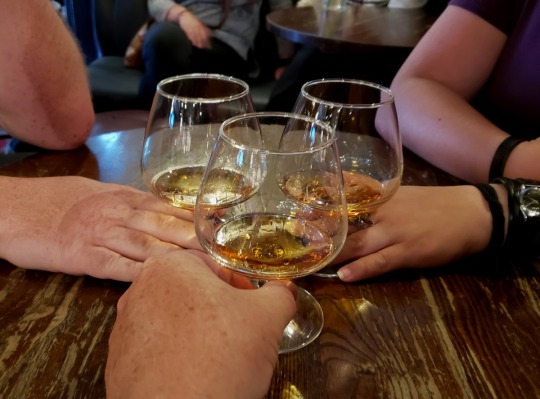
After lunch, we took an Uber back to the World’s End, where we each had a shot of Drambuie in honor of my dad’s Scottish friend John. For those of you who didn't know either, Drambuie is a sweet liqueur made from Scotch whisky, honey, and spices. A very distinctive beverage, it somehow manages to be both delicious and disgusting at the same time.


Our long-awaited toast complete, we decided to make it an official pub crawl and continued over to the BrewDog pub on Cowgate. My dad and I had learned about Brewdog from the TV show Brew Dogs, where the two Scottish brewers who run BrewDog travel the US crafting locally inspired novelty beers and converting beer skeptics to the way of the hop.
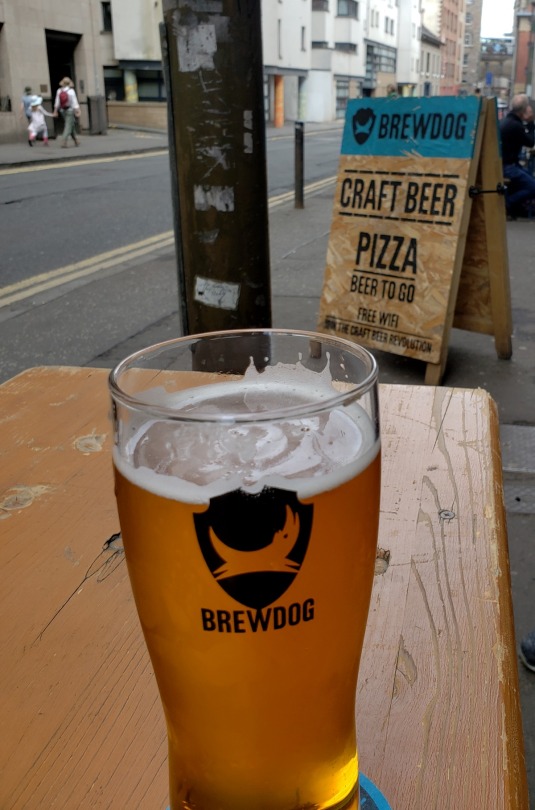
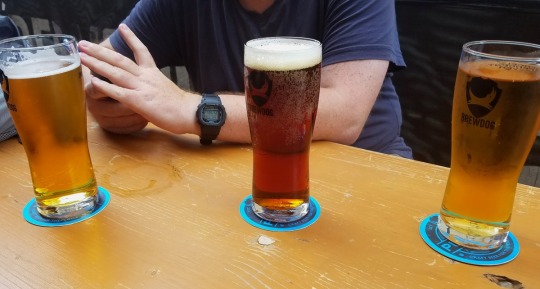
My dad had their signature Punk IPA, and I had their 5AM Saint red ale. I generally don’t like IPAs, but the Punk was surprisingly well-balanced despite being so hoppy. It had the sour and citrusy notes of a typical IPA, but very little bitterness. My ale was also surprisingly good. It was hoppier than any other red or amber ale I’ve had before, but the bright hoppy notes actually did a great job balancing out the ale and making it refreshing instead of heavy.
Jessica had a cider that was pretty good, too.
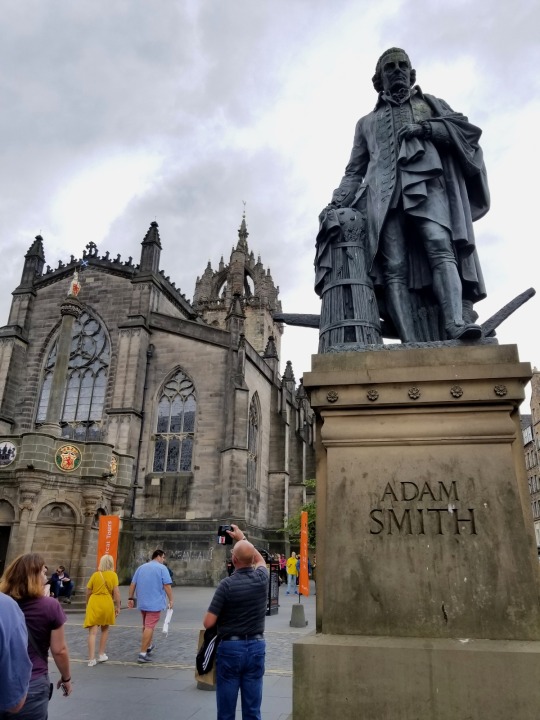


Went to St. Giles’ Cathedral, the seat of the Church of Scotland. It isn’t the largest, but it is stunning inside. The stained glass is mostly modern, but it is strikingly good.



It's free to enter the cathedral, but you are expected to pay if you want to take pictures. And we can confirm that the people working there will not hesitate to call you out for breaking the rule.
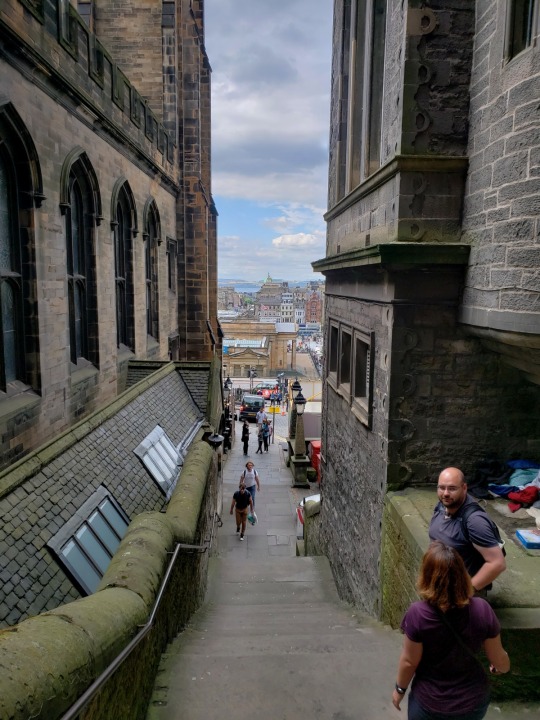

We still had some shopping to do--including picking up something for dinner--so we decided to walk over to New Town. I lead us along my footsteps from the previous day, taking Jessica and my dad through narrow closes and down the hill.
Tomorrow, we would head out early for Islay, so we caught a bus home with plenty of time to rest up and start packing.
Before I close our chapter on Edinburgh, I have to mention our charming hosts, Joyce and Ian. They were very kind and accommodating, but sometimes we felt that they didn't expect us to take them up on their offers as much as we did.
For example, they said we couldn’t use the kitchen to cook, but we could use it to heat a ready meal up in the oven. On our last night, we bought some meat pies that we didn’t realize at first weren’t microwavable. Ian said that it would be no problem for us to use the oven, and he even showed us some tips on how to get the crust to brown up just right. But when Joyce showed up and asked suspiciously what we were up to, Ian was nowhere to be seen.
It was a good time, and I’m glad that Jessica and I got to enjoy the British bed and breakfast experience several times during our months on the island. But we really found out just how strongly we prefer having a place to ourselves with a proper kitchen that we can use whenever we want.
Next Post: Islay (Introduction and Arrival)
Last Post: Hadrian’s Wall and the Scottish Borders
1 note
·
View note
Text
The Miraculous Discovery of Captain America
Happy New Year, @jemmahearteyessimmons!!! For a second year in a row, I am your FitzSimmons Secret Santa!! I’m sorry I didn’t get this posted when I said I would, but I hope you enjoy it!!
Prompt: Fitzsimmons Buzzfeed Unsolved AU
Summary: Fitz and Jemma record an episode and then go out to celebrate Fitz's birthday with their friends.
Read on AO3
Jemma entered the studio and smiled at the sight of her best friend sitting at their desk reviewing his script. “Fitz!” she cried cheerfully, “happy birthday!”
Fitz looked up and smiled at her. “Thanks! You’re coming to Hawkins’ Pub with the group tonight, right?”
“Wouldn’t miss it for the world,” Jemma told him.
She sat down next to him and a comfortable silence fell as Fitz went back to reviewing his notes and Wendy came over to apply make-up. There was a map of Greenland and the Arctic on the desk in front of them. Jemma pulled out her own copy of the script and reviewed it quickly.
“Okay, are we ready?” the director asked, coming over to stand in front of the desk. Jemma and Fitz nodded and put their scripts away. The director moved behind the camera. “Three, two, one, action.”
“Today on Buzzfeed Unsolved,” Fitz began, “we’re looking into the miraculous discovery of Captain America. Captain America, also known as Steve Rogers, was born on the 4th of July, 1918-”
“Very patriotic,” Jemma commented.
“Very patriotic, indeed, Simmons,” Fitz said. “When World War II began, Steve Rogers joined the army as soon as he was able, serving first as an actor promoting war bonds, before finally joining the famous Howling Commandos, where he got to see a bit of action. Steve Rogers’ plane went down in the Arctic Ocean in 1945 and he was assumed dead. However, in July 2011, Steve Rogers was found, still alive. Now, we know the story we’ve been told, that Steve Rogers was given a super serum that made him into a real life superhero and that serum allowed him to survive in ice for nearly seventy years, but what exactly that serum was, was never released to the public. If there actually was some kind of magic potion that could change people the way it allegedly changed Steve Rogers, why haven’t more people recreated it and used it for themselves?”
“Others have tried,” Jemma said. “Bruce Banner, for one. And Peggy Carter wrote in her autobiography that the serum was deemed too dangerous to keep.”
“That’s assuming the serum is in fact the truth,” Fitz said.
“You have other theories?” Jemma asked.
“I do have other theories,” Fitz confirmed. “Three, to be exact.”
Jemma sighed. “All right, let’s hear them.”
“Theory one: This man claiming to be Steve Rogers, is not, in fact, the real Steve Rogers.”
“So, he’s like the Dread Pirate Roberts?”
“Yes,” Fitz agreed, “or maybe Anastasia.”
“So, you’re saying the real Steve Rogers is actually dead, and this man is an imposter.”
“Yes.”
“That’s depressing. And how is he faking the super strength? That’s not really something you can fake.”
“Maybe he has a punishing exercise routine?” Fitz suggested.
“I don’t buy this theory,” Jemma told him.
“Okay, then theory two: Cloning.”
“Like Dolly the sheep?”
“Yeah, like Dolly the sheep. What if Captain America did crash in the Arctic, but was rescued before he died? He knew the world would continue to need superheroes, so he had his rescuers take DNA samples, in order to be used for cloning purposes.”
“But why wait until 2011 to reveal this cloned Captain America?”
“Maybe the first attempts at cloning didn’t work out?” Fitz suggested. “Plus, they would have had to wait until the clone grew up and was the same age as the original.”
“Well, this theory is a bit more likely than the super serum, but I’m still not fully buying it.”
“Well, wait until you hear my third and final theory,” Fitz told her. He paused for dramatic effect. “Aliens!”
Jemma rolled her eyes. “Ugh, Fitz!”
“What if, when Captain America’s plane went down, aliens happened to be passing by Earth and decided they needed a superhero of their own?”
“Some kind of guardian of the galaxy?” Jemma asked sarcastically.
“Exactly! Captain America helped the aliens fight their battles, and then requested that they drop him off exactly where they found him.”
“Then how do you explain him not aging?”
Fitz shrugged. “Erm, they kept him in cryo-freeze when they didn’t need him?”
Jemma rolled her eyes again. “Look, as improbable as it sounds, I believe the initial theory that we were told about Captain America.”
“But you only believe it because Peggy Carter says it’s true.”
“What’s wrong with that?”
“Because what if she only says it’s true because she was forced to say it’s true?”
“What?”
“I dunno, some Men in Black type agency feeds her this lie in order to cover up the alien abduction.”
“Ugh, Fitz!”
Fitz smiled at the camera. “You know what I believe; you know what Jemma believes; now, you lot will have to decide for yourselves about the truth behind Captain America’s miraculous discovery.”
“Cut!” the director called out. “That was good, guys. Jemma, maybe you could add a little more eye rolling? And Fitz, a bit of a longer pause before the alien theory. Okay, let’s go again, guys.”
They spent the next few hours re-shooting with different camera angles, new line additions, and various reactions. When they were finally done, Jemma was more than ready to relax at the pub with Fitz and their friends.
Some would call Hawkins’ Pub--with its 80’s theme--hipster, but Jemma preferred to think of it as charming. She and Fitz entered and immediately spotted their friend, Daisy Johnson, at the bar, flirting with the young, 20-something bartender who had a glorious mane of hair.
“Hey, guys,” Daisy said cheerfully when they approached her. “I was just telling Steve here all about your birthday, Fitz. He’s promised us some free drinks.”
“Happy birthday, dude,” Steve said, handing over a tray of shots.
“Cheers, mate,” Fitz told him as he picked up the tray.
Daisy led them to a large, round booth where Mack, Elena, Piper, and Prince were waiting. There was a chorus of greetings and “happy birthday”s as Fitz and Jemma slid in.
“Davis texted,” Piper announced. “Their babysitter fell through, so his wife is gonna stay home while he comes to celebrate.”
“They could’ve just brought the baby,” Hunter commented as he and Bobbi approached the booth. “That’s what we did.”
“We didn’t really have a choice,” Bobbi said, one hand rubbing her rather large, pregnant belly. “Get me a chair, Hunter; I won’t be able to fit in the booth.”
“Yes, dear,” Hunter said.
“So, what crazy theories did you record today?” Piper asked Fitz and Jemma once everyone had settled into the booth.
“Captain America was abducted by aliens to be a guardian of the galaxy,” Fitz told her and everyone at the table began to laugh.
“What if he’s some sort of programmable robot?” Elena suggested.
“Oh, that’s a good one!” Fitz said. “Maybe we could do another quick reshoot tomorrow?” he suggested to Jemma.
“Maybe,” Jemma said, “but we’re supposed to be filming about that little girl from Indiana that people claimed was telekinetic.”
“Telekinetic, that would be a cool superpower,” Hunter commented.
“Oooh, let’s go around and name your ideal superpower,” Daisy suggested. “I’ll go first! Um, well, telekinesis would be nice, or maybe super strength. What about you, Fitz?”
“Erm, the ability to talk to animals?” he suggested.
“Animals, or just monkeys?” Mack asked.
“Well, I’d mainly use it to talk to monkeys,” Fitz admitted.
“You could have a monkey sidekick!” Daisy suggested.
“Yeah!” Fitz grinned at the idea. “He could help me get through laser fences with his adorable little hands.” He turned to Jemma. “What superpower do you want, Simmons?”
Jemma thought, one hand tapping her chin. “Oh, I know! The ability to breathe in places where humans typically can’t, such as underwater, or in outer space.”
Mack chose the ability to know if someone was a robot or not, Elena chose super speed, Hunter chose X-ray vision or invisibility, Bobbi chose healing powers, Prince chose teleportation, Piper chose flight, and Davis, when he arrived, chose the ability to see the future. Fitz and Davis then got into a discussion/argument over the possibility of being able to change the future.
Jemma smiled as she listened to their friendly bickering, chiming in occasionally to help Fitz prove his point about spacetime. She really did have the best friends. Her mind drifted toward Steve Rogers. If he really was a man out of time, like they’d all been told, and not some sort of clone or alien, then all of his friends were dead. How sad.
She was quiet as she and Fitz walked back to her apartment, her mind still on Captain America and everything he had lost. They stopped outside her door, and Jemma fidgeted with her key.
“Fitz,” she said, and he turned to look at her with an expectant smile. “I’ve been thinking a lot about how much Steve Rogers lost, being frozen for nearly 70 years, and I just want you to know--you’re my best friend in the world, Fitz.”
Fitz smiled. “I love you, too, Jemma.”
Jemma kissed his cheek. “Happy birthday, Fitz.”
#fitzsimmonssecretsanta#jemmahearteyessimmons#thefitzsimmonsnetwork#aosficnet2#fitzsimmons#agents of shield#fanfiction
19 notes
·
View notes
Text
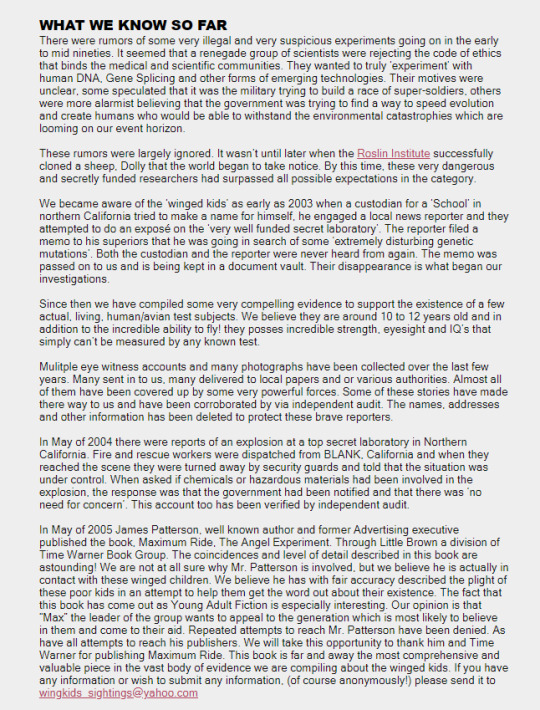
Text:
WHAT WE KNOW SO FAR
There were rumors of some very illegal and very suspicious experiments going on in the early to mid nineties. It seemed that a renegade group of scientists were rejecting the code of ethics that binds the medical and scientific communities. They wanted to truly ‘experiment’ with human DNA, Gene Splicing and other forms of emerging technologies. Their motives were unclear, some speculated that it was the military trying to build a race of super-soldiers, others were more alarmist believing that the government was trying to find a way to speed evolution and create humans who would be able to withstand the environmental catastrophies which are looming on our event horizon.
These rumors were largely ignored. It wasn’t until later when the Roslin Institute successfully cloned a sheep, Dolly that the world began to take notice. By this time, these very dangerous and secretly funded researchers had surpassed all possible expectations in the category.
We became aware of the ‘winged kids’ as early as 2003 when a custodian for a ‘School’ in northern California tried to make a name for himself, he engaged a local news reporter and they attempted to do an exposé on the ‘very well funded secret laboratory’. The reporter filed a memo to his superiors that he was going in search of some ‘extremely disturbing genetic mutations’. Both the custodian and the reporter were never heard from again. The memo was passed on to us and is being kept in a document vault. Their disappearance is what began our investigations.
Since then we have compiled some very compelling evidence to support the existence of a few actual, living, human/avian test subjects. We believe they are around 10 to 12 years old and in addition to the incredible ability to fly! they posses incredible strength, eyesight and IQ’s that simply can’t be measured by any known test.
Mulitple eye witness accounts and many photographs have been collected over the last few years. Many sent in to us, many delivered to local papers and or various authorities. Almost all of them have been covered up by some very powerful forces. Some of these stories have made there way to us and have been corroborated by via independent audit. The names, addresses and other information has been deleted to protect these brave reporters.
In May of 2004 there were reports of an explosion at a top secret laboratory in Northern California. Fire and rescue workers were dispatched from BLANK, California and when they reached the scene they were turned away by security guards and told that the situation was under control. When asked if chemicals or hazardous materials had been involved in the explosion, the response was that the government had been notified and that there was ‘no need for concern’. This account too has been verified by independent audit.
In May of 2005 James Patterson, well known author and former Advertising executive published the book, Maximum Ride, The Angel Experiment. Through Little Brown a division of Time Warner Book Group. The coincidences and level of detail described in this book are astounding! We are not at all sure why Mr. Patterson is involved, but we believe he is actually in contact with these winged children. We believe he has with fair accuracy described the plight of these poor kids in an attempt to help them get the word out about their existence. The fact that this book has come out as Young Adult Fiction is especially interesting. Our opinion is that “Max” the leader of the group wants to appeal to the generation which is most likely to believe in them and come to their aid. Repeated attempts to reach Mr. Patterson have been denied. As have all attempts to reach his publishers. We will take this opportunity to thank him and Time Warner for publishing Maximum Ride. This book is far and away the most comprehensive and valuable piece in the vast body of evidence we are compiling about the winged kids. If you have any information or wish to submit any information, (of course anonymously!) please send it to [email protected]
0 notes
Text
How far can a body extension go? Can I body extend myself where I shouldn’t go?
Through those two first questions I was asking myself until where/ when can my extension go. I took the word body extension with is first definition. An extension of your own body.
Motionless my limbs can reach my surrounding, the space around me (cf Leonard de Vinci, Vitruve’s body). With his movements the human body can spread and attain the place it wants. The body uses machines to get in those places « extension » like cars, bikes, plane, boat, rocket… The devices created help the humans to go faster but the speed has it limits.
Holograms in 3d movement, video call in 2d movement, voice call in a 0d movement and even a picture of you allow a projection of yourself where you are not supposed to be and so get in contact with « unreachable » space. The duplication of the body can also be created by cloning (first mammal coning in 1996 with a sheep, Dolly) or by procreation, where you DNA is transmit to an other individual. Avatars in video game are others projections of yourself in a new way. ( cf the Congress : movies about the « real » virtual life). Loophole of the life, our avatars are going in unreachable spaces doing impossible actions guided by us. Unreachable and impossible but visible. We invented new spaces and new ways to get in.
Why would I want to reach the unreachable? To achieve the unachievable. To go further, to surpass myself. To live faster, longer.
Ideas building with Matthieu and Mathis
Stretching your limbs to reach everything
Video/ pictures about before/ after
Holograms in other contries, planets
Getting in others body, chip or camera to see inside
Projection of yourself really fast
Cannon in circus to project dwarfs
Trampoline in your environment to go faster
Bouncing shoes with spring : going faster in the first movement you are making: walking
drawing-and-quartering machine « 10 minutes a day »
Growing during pregnancy : action on the spine
Going inside my own body : chip to play a video game in my veins
Vacuum or magnet : new interaction with the environment, new ways of moving
Referances :
-Palais de Tokyo exhibition : Taro Izumi, installation where you can position yourself in unexpected position in movement. For instance the second where the goal stop the ballon with his hands.
-French Kiss; Japon device where you can kiss a person which is miles away through a connected tongue. https://www.youtube.com/watch?v=PspagsTFvlg
Finally what we need the most is to increase our life flow to reach « the » place where we were not supposed going.
Drugs like amphetamines are psycho-stimulator synthetics. Their chemical structures looks like the stimulaters that the body product naturally. Bioamines like adrenaline, noradrenaline, sérotonine, dopamine and hydroxytryptamine. With those natural secretion the body feel more strong, the brain happy and able to reach a state of peace and tranquility.
Book about speed and time :
« Vitesse et Aliénation » of Harmut Rosa
« être et temps » Martin Heidegger
« la vie liquide » Zygmunt Bauman
Babies making with Frederik
Frederik’s ideas : communication between people and communities
-Facial languages and expression into energy
-Noise of the voice (sound energy) into electricity to create an electric shock while touching the person you are mad to
-energy in breathing
-natural energy of the body into electricity : blood flow like tidal stream energy; weight like gravity energy; breathing energy like wind energy; movement of the body as kinetic energy;…
-nerves and electricity
-send your minds without communicate them by nerves and electrical shocks
-holograms of you before on the same activity: for instance biking, an hologram of your self the day before or a medium of the week or the month.
Creating energy with the body is a really interesting subject and I looked deeper in that direction. And especially humans creating energy for their technologies. Technologies are a way to free humans from work and can enable people to live their life more freely.
Energy gravity
http://lenergeek.com/2015/12/10/la-gravite-une-nouvelle-source-denergie-exploitable/
http://strabic.fr/Nick-Srnicek-Alex-Williams-Accelerer-le-futur
Backpack in electrical energy
https://www.usinenouvelle.com/article/le-sac-a-dos-transforme-le-mouvement-en-electricite.N47215
Go faster in life: shoes to run faster or to fill up battery
Enko, des baskets de running avec suspension pour une meilleure accélération
https://www.wanarun.net/blog/adidas-spring-blade-la-chaussure-a-ressort-31757.html\
Un grand pas pour l’écologie : rechargez vos appareils mobiles en marchant avec ces chaussures ingénieuses
Un grand pas pour l’écologie : rechargez vos appareils mobiles en marcha...
Maxime Magnier
Dans un souci toujours plus grand de préserver l’environnement, beaucoup d’entreprises se tournent vers la reche...
Clothes using the warmth of the body to produce energy
Vêtement piézo-électrique — Wikipédia
Vêtement piézo-électrique — Wikipédia
Noises to create energy
Futur : le bruit, nouvelle source d’énergie
Futur : le bruit, nouvelle source d’énergie
Des architectes ont imaginédes immeubles capables de convertir le vacarme de la ville en électricité inépuisable.
Blood flow to create energy
La circulation sanguine, une source d'énergie?
La circulation sanguine, une source d'énergie?
Un dispositif à combustible capable de produire de l'électricité grâce à une immersion dans le flux sanguin a ét...
Convertir le flux sanguin en électricité, le futur de l'énergie ? - L'Atelier BNP Paribas
Convertir le flux sanguin en électricité, le futur de l'énergie ? - L'At...
Des chercheurs chinois sont parvenus à convertir le flux sanguin en électricité.
Breath to produce energy
https://www.consoglobe.com/respirer-produire-electricite-cg
Gravity/ Weight as energy
http://lenergeek.com/2015/12/10/la-gravite-une-nouvelle-source-denergie-exploitable/
Then I get interested by potential energy In physics, potential energy is the energy possessed by an object because of its position relative to other objects, stresses within itself, its electric charge, or other factors.[1][2]
Common types of potential energy include the gravitational potential energy of an object that depends on its mass and its distance from the center of mass of another object, the elastic potential energy of an extended spring, and the electric potential energy of an electric charge in an electric field.
I like that theory of potential energy which link the envy to go further, to link people between each other to create power and electricity.
The last question was : HOW TO CREATE POTENTIAL ENERGY BETWEEN PEOPLE?
https://en.wikipedia.org/wiki/Potential_energy
0 notes
Text
#gallery-0-4 { margin: auto; } #gallery-0-4 .gallery-item { float: left; margin-top: 10px; text-align: center; width: 33%; } #gallery-0-4 img { border: 2px solid #cfcfcf; } #gallery-0-4 .gallery-caption { margin-left: 0; } /* see gallery_shortcode() in wp-includes/media.php */
Shoukhrat Mitalipov is an American biologist who heads the Center for Embryonic Cell and Gene Therapy at the Oregon Health & Science University in Portland. He is known for discovering a controversial genetic therapy that may be a way to prevent mitochondrial diseases, as well as a new way of creating human stem cells from skin cells.
A U.S. research team has reportedly edited the DNA of a human embryo just as a sperm fertilizes an egg, well before its eight-cell stage. alxpin/iStockphoto
Jessica Newell was born with Leigh Syndrome, a form of mitochondrial disease.
The research targeted a hard defect, but experts say in the future the same approach can potentially prevent a whole list of inheritable diseases
By Roberto Hugo Gonzalez
As originally published by Mega Doctor News in its newsprint edition August 2017
For the first time, in decades scientists in the United States have edited the DNA of human embryos to prevent a fatal disease. An American researcher, of Russian descendants, has successfully done this with animals.
Genes cause the disease called hypertrophic cardiomyopathy. In other words, if you inherit a gene with a mutation on it, you’re going to make some of the proteins in your heart in an imperfect way, it’s just something you were born with.
Hypertrophic cardiomyopathy (HCM) is very common and can affect people of any age. It affects men and women equally. It is a common cause of sudden cardiac arrest in young people, including young athletes.
With this disease, it is impossible to know when your heart might fail you, never knowing if today is the day when it might go off. Some have said that it’s like you’re just walking around every day with a gun pointed at your head.
The researcher behind this breakthrough is Dr. Shoukhrat Mitalipov, Ph.D., heads the Center for Embryonic Cell and Gene Therapy at the Oregon Health & Science University in Portland Oregon. He grew up in the Soviet Union when Kazakhstan used to be of the Soviet Union; he is also an accomplished blues guitarist.
He became interested in studying the cells in embryos when he was in school in Moscow. As soon as he graduated, he came to the United States and started to work with a mentor, Dr. Keith Campbell, the scientist that helped to create the first cloned animal, Dolly the sheep/ The sheep may not be the monster imagined in a science-fiction fantasy. It is important to note that, many scientists doubted it could ever be done.
Mitalipov’s medical breakthrough is of epic proportions. Today, the United States law may block this type of medicine prevention, leaving people never knowing when their hearts will fail.
Last week a group of scientists led by Mitalipov published a breakthrough that could do just that: edit and rewrite the gene that causes this heart condition. TV commentators said, “Genetic engineering yesterday was science fiction, and today it’s reality.”
Hypertrophic cardiomyopathy occurs if heart muscle cells enlarge and cause the walls of the ventricles (usually the left ventricle) to thicken. The ventricle size often remains normal, but the thickening may block blood flow out of the ventricle. If this happens, the condition is called obstructive hypertrophic cardiomyopathy.
Sometimes the septum, the wall that divides the left and right sides of the heart, thickens and bulges into the left ventricle. This can block blood flow out of the left ventricle. Then the ventricle must work hard to pump blood. Symptoms can include chest pain, dizziness, shortness of breath, or fainting.
Hypertrophic cardiomyopathy also can affect the heart’s mitral valve, causing blood to leak backward through the valve. Sometimes, the thickened heart muscle doesn’t block blood flow out of the left ventricle. This is referred to as non-obstructive hypertrophic cardiomyopathy. The entire ventricle may thicken, or the thickening may happen only at the bottom of the heart. The right ventricle also may be affected.
In both obstructive and non-obstructive HCM, the thickened muscle makes the inside of the left ventricle smaller, so it holds less blood. The walls of the ventricle may stiffen, and as a result, the ventricle is less able to relax and fill with blood.
But how exactly does one edit a gene to fix that problem? According to the scientists, this recent breakthrough is an application of a new kind of tool for rewriting DNA called CRISPR, which allows for quick and easy genome editing.
CRISPR is the only complete genome editing solution designed to expedite research.
What scientists did was they created an embryo that had Hypertrophic cardiomyopathy disease, in other words, one copy of a gene from a heart protein that was faulty. They added in molecules to this embryo, which was able to zero in on the part of the gene where this mutation was that causes this disease.
Carl Zimmer is an award-winning science writer. He’s a columnist for the New York Times and the author of 13 books about science. His comments about editing the human embryo are interesting and timely. “It’s like they’re paging through an incredibly long encyclopedia until they get to a particular page. On that particular page, they get to a particular paragraph, and in that particular paragraph, they get to a particular word. They can zero in with that kind of incredible accuracy, and then they cut a section of the DNA, where scientists can insert a new piece of DNA to take its place.” This technique repairs the DNA, and in the process, it turned that gene into a normal version that lets us have regular beating hearts.
Michael Barbaro, the conductor of The Daily of the New York Times, said, “So, they’re removing a word in this deep well of language, and they’re replacing with another one.”
Zimmer pointed out that if this embryo would ever become a fully formed human, it would be a human without this terrible disease. In essence, it just would be eradicated from the biology of the baby and the adult. The scientist Dr. Mitalipov also said, “I was really shocked, so this is kind of a big moment for me to understand that we have more power in manipulating nature than we think.”
The United States has been opposed to genetic modifications in human embryos for quite a long time; they have made it very clear that they’re not going to approve clinical trials for Mitalipov’s project.
In 2016 Congress inserted a little line into the budget saying that the FDA cannot even consider an application to mitochondrial replacement therapy. Because of that, Dr. Mitalipov stated, “It’s frustrating because, you know, the goal of my career it’s to bring new revolutionary treatments. We invested so much into the science and accomplished so much progress, and now all of a sudden the FDA has told us not to pursue this work.”
For Dr. Mitalipov was important that this could be a way to cure genetic diseases. He initially became famous for all he did in research at what came to be known as three-parent-babies.
It’s an idea that bends the mind as well as the established laws of nature, one baby, with three genetic parents. As an example, 13-month-old Jessica Newels suffers from a mitochondrial disease passed down from her mother and doctors say things will get progressively worse.
It is known that we only inherit mitochondria from our mothers and if there’s mutation on one of those genes it can cause really severe diseases. Scientists combined the DNA of 2 parents with a healthy mitochondria DNA of a female donor, and that’s where you get a three-parent-baby.
So, the question is, what happened with that research of this three-parent-baby concept? It worked on mice, and so then Mitalipov moved onto monkeys which are closer to humans. Two baby monkeys were born and cured of their mitochondrial disease.
The success of his research gave him and others a certain boost to say, “okay let’s go to government agencies and ask for permission to apply this technology in humans.” In the United States, it’s just a very different story, the answer to that was a big NO. The United Kingdom opened its doors, and they have gone forth with approving it and moving forward with this, full steam ahead with lots of regulations.
Dr. Mitalipov said, “I understand that you need to draw a line, what’s permissible what’s not. We don’t want a neglected use, but what we’re asking is let us test it. It needs to be tested in clinical settings.”
Zimmer said, “Even the scientists themselves have been stunned by how fast they’ve been hitting these successes and scientists are making an effort to try and make the rest of us aware of what CRISPR is and what the potential benefits and ethical issues are.”
Dr. Mitalipov also said, “I don’t think, you know, this technology can’t be stopped at this stage, and I believe this is going to be the future, and an initial interest of every country, the United States has just to reconsider their policies.”
Zimmer said, “It’s really hard for me to look into the future on this one, because when you look at our past experiences, sometimes things go from being really shocking and hard to find them normal.” He continued, “Vitro Fertilization in the 1960’s was considered very scandalous, and most people were against it.” Today, he pointed out it’s extremely common, regulated, it’s licensed in the US, and it’s just a familiar part of life. “So, the question is will CRISPR become a familiar part of life 50 years from now? I really don’t know,” Zimmer said.
Barbaro said, “So, you say this is truly revolutionary in the world of science and medicine. Why is it such a big deal?
Zimmer responded, “For decades, the scientists wanted to do this. To be able to fix genetic diseases by manipulating embryos. In other words, it’s possible that if you took one of these embryos, and implanted it in a surrogate mother, the embryo will develop into a normal human being, healthy despite having edited DNA, and, in fact will not carry the disease that they have inherited, and not only that, but will not pass it down to their descendants.”
Also, Dr. Mitalipov said, “I know in the future this kind of treatments will become routine probably a million children will be cured of these inheritable conditions and that’s what nature is every day.” He continued, “I didn’t want to be just a scientist or be the best of the best, I wanted to be number 1, and then hopefully show everybody that they’re wrong. 100 years from now they’re going to remember “Yeah that’s Mitalipov, he developed it.”
The U.S. National Academy of Sciences (NAS) report notes that many inherited diseases can be prevented by selecting healthy embryos for in-vitro fertilization, and that embryo editing might only be justified if it presents the only option for a couple to have a healthy biological child. Congress has meanwhile prohibited the U.S. Food and Drug Administration from reviewing applications for clinical trials involving embryo editing.
Scientists Successfully Eliminated a Genetic Disease from Human Embryos The research targeted a hard defect, but experts say in the future the same approach can potentially prevent a whole list of inheritable diseases…
0 notes
Text
The ethics of cloning
Artificially cloning animals using an adult cell has been a scientific possibility since the late 90s when a sheep was successfully cloned in Roslin Institute. Most people know this as Dolly the sheep. However, people have questioned the ethics of cloning for as long as it's been a possibility. Is there an increased likelyhood of birth defects in clones? It's morally wrong to create a clone? Let's see what people thought at the time, and what they think now. First of all, how did they do it? Well, they took the cell of an adult sheep and turned it off in a way. They then inserted it into a hollowed out, unfertilized egg, and puthe all that into a "surrogate mother". This is an animal that takes that place of the clones mother. They let it grow inside the mother and waited until it was born. Most of the other clones would die before, during, or a few days after birth. In fact, 277 died. But "Dolly" was the only one that didn't. And she was the first animal to be cloned using an adult cell. As you could imagine, being able to successfully clone an animal as large as a sheep is a major scientific breakthrough. And it was. It led us closer to understanding how life works. But many people had issues with it. The entire reason that the scientist chose to clone an animal using adult cells and not embryonic cells (a much easier way of cloning) is because cloning was a very new scientific breakthrough and the ethics of it were heavily questioned. Specifically, the harvesting of cells from a dead embryo. People had a big issue with this, and so cloning was extremely controversial. This is why the scientists at Roslin Institute chose to use this method of cloning. However, as we know, the media can sometimes try to feed of controversy, and will sometimes perpetuate it. When Dolly was put down because of a lung tumour when she was 6 years old, lots of people blamed it on the "effects of cloning", trying to make it seem bad. But lung tumours are actually very normal for sheep living indoors, and it was practically expected of her to develop a tumour. She produced normal, healthy offspring and lived a typical sheep-based life. However, people still wanted to make it seem that cloning was ethically wrong. I personally believe that cloning is ethical and moral, as long as it is done respectfully and efficiently. As in, no animals are unnecessarily harmed. I believe that cloning will lead us to new scientific discoveries about life.
0 notes
Link
Human-Pig GMO Created at Vaccine Institute Dr. Mercola By Dr. Mercola In Greek mythology, a chimera is a fire-breathing monster created from different species, most often portrayed as a creature with a lion’s head, a goat’s body and a serpent’s tail. Chimeras have long been regarded as mythical creatures, to the extent that the word “chimera” also means “an illusion or fabrication of the mind” or “an unrealizable dream.”1 Among humans, chimeras, or people who have two genetically distinct types of cells, do exist, however. Most often this occurs among non-identical twins who shared a blood supply in the uterus and end up having more than one blood type (they’re known as blood chimeras). The idea of a human-animal chimera has remained confined largely to mythology, however — until now. First Human-Pig Hybrid Created Researchers from the Salk Institute for Biological Studies in La Jolla, California, have made history by creating a human-pig hybrid, a task achieved by injecting days-old pig embryos with human pluripotent stem cells.2 Such cells, like embryonic stem cells, are able to divide indefinitely and become any type of cell in the body. The human-pig embryos were then transferred into adult pigs and allowed to grow for up to four weeks, before they were “removed and analyzed.”3 The study noted that more than 2,000 hybrid embryos were transferred into surrogate sows, but only 186 later-stage chimeric embryos survived the process, each with about 1 in 100,000 human cells. The long-term goal of such research is to figure out if it’s possible to grow human organs inside other species, like pigs. Human embryo development, drug development and disease processes could also be studied using chimeras. Animal chimeras have been developed in the past. For instance, researchers genetically engineered (GE) rat embryos to not produce a pancreas (which controls blood sugar levels), then injected mouse stem cells into them, which resulted in the growth of pancreatic tissue. They were then able to treat diabetes by transplanting parts of the healthy organs into diseased mice.4 The development of human-animal chimeras has, however, remained in the realm of science fiction until now. Aside from the glaring ethical considerations, these types of experiments have been ineligible for public funding in the U.S., which is why the Salk Institute has had to rely on private funding for the study.5 US May Lift Funding Ban on Human-Animal Chimeras In September, 2015, the U.S. National Institutes of Health (NIH) issued a moratorium on funding research involving injecting human stem cells into animals. While human cells have long been studied in animal models, such as growing human tumors in mice, “the new research is different, because potent human stem cells are being injected directly into a very early-stage animal embryo, consisting of just a couple of dozen cells,” MIT Technology Review reported. “Theoretically, the human cells could then end up contributing to any part of the animal, and in any amount.”6 NIH was right to be wary, but by August, 2016, they’d announced a plan to potentially lift the funding moratorium, noting that such experiments “are really important and exciting to understand how disease works.”7,8 In addition to forming a special committee to oversee funding of human-animal hybrid research, they announced that funding for research involving combining human cells with early ape or monkey embryos would continue to be forbidden. The concern is that such research could inadvertently create a human-like ape, leading to consequences we’ve only begun to contemplate. As of January, 2017, NIH’s funding ban is still in place, which certainly seems pragmatic, to put it mildly, given the risks involved. As MIT Technology Review pointed out:9 “The agency also wants to explicitly bar any of these human-animal chimeras from being allowed to reproduce. The risk — very remote but which could have disastrous consequences for public confidence in science — is if two chimeras mated and gave rise to a human fetus. That could happen if their sperm or egg were human.” Human-Animal Embryos: What Possibly Could Go Wrong? The ability to grow human organs is undoubtedly an intriguing area of research, especially as about 76,000 Americans sit in wait of healthy organs for transplant.10 But the reality is that these GMO technologies could have unforeseen and devastating consequences. “The work inevitably raises the specter of intelligent animals with humanized brains and also the potential for bizarre hybrid creatures to be accidentally released into the wild,” The Guardian noted.11 Indeed, no one knows if inserting human cells into non-human animal embryos might lead to the creation of non-human animals with human consciousness. Neuroscientist Lori Marino, Ph.D., executive director of the Kimmela Center for Animal Advocacy, told STAT News:12 “These organisms may be capable of self-awareness to the extent that they understand their identity and circumstances, which would produce unbearable suffering. Will we know when the subjective experience of such a being has crossed the generally accepted line of decency and morality? If we cannot say with certainty that this will never happen, then we need to stop this kind of research right now before we find ourselves in a world where there is no line.” If organs can one day be grown inside animals, we’re then faced with the realities of whether this — raising animals for the sole purpose of organ harvesting — can and should be done, ethically speaking, It falls into the realm of research moving full-steam ahead before we’ve adequately stopped to consider whether we should move forward at all. Marino continued:13 “As we continue down the path of this unprecedented manipulation of sentient beings and pour funding into it, we simultaneously limit funding for alternative solutions to our health problems, including prevention, consensual human trials, incentives for organ donation, microchip testing and in vitro research. All too soon, when we look back on the path of chimeric research that we’ve chosen, we may not like what we see. But by then it will be too late.” Challenges to Chimera Research Some of the more unsettling questions raised in combining human stem cells with pig embryos include whether the resulting progeny may resemble humans more than pigs, or whether the human cells could overtake the pig cells, resulting in an offspring that’s mostly human but “slightly pig.”14 Other issues include the differing rates of embryonic development in different species. Pig pregnancies are much shorter than human pregnancies, for instance, so for the Salk Institute study to be successful, the researchers had to inject the human stem cells at exactly the right phase in development. It was an accomplishment four years, and 40 people, in the making, with lead author professor Juan Carlos Izpisua Belmonte, of the Salk Institute's Gene Expression Laboratory, noting “We underestimated the effort involved.”15 Although it’s thought the human cells were only involved in the formation of muscle, and no human cells were observed in the brain region, Belmonte noted “we cannot exclude the possibility that they may have gone to the [pig] brain.”16 Next, the researchers plan to genetically edit the pig embryos, which is being made increasingly possible via technology like the gene-editing tool CRISPR, to “delete” organs in the hopes that injected human stem cells will then take over to create human organs inside the pigs. Gene-Edited Foods Are Already Here CRISPR gene-editing technology has been taking the medical world by storm, but lesser known is that CRISPR and other gene-editing tools are also being used in the food industry. Gene-edited crops, in which DNA is tweaked or snipped out at a precise location, have already been created — and eaten. The New York Times reported on the first dinner on Earth with gene-edited foods, including soybeans and potato produced by a pharmaceutical company called Cellectis. Unlike GE foods, which may have genes from other species inserted: “There is nothing taken out or added to the plant,” André Choulika, chief executive of Cellectis, told the Times. “It’s what nature would have produced.”17 It’s too soon to say what gene editing may do to food and the environment, for better or for worse but, as is the case with human-pig chimeras, the technology is already forging ahead, so we’ll inevitably find out, sooner or later. Foods produced via gene-editing are not subject to regulation by the U.S. Department of Agriculture (although an advisory board recommended gene-edited foods could not be labeled organic) or other regulatory agencies. “They, at least for now, largely fall outside of current regulations,” the Times reported.18 To date, the technology has been used to produce soybeans with altered fatty acid profiles, potatoes that take longer to turn brown, and potatoes that remain fresher longer and do not produce carcinogens when fried. The latter could be sold as early as 2019. What Does the Future Hold? You may remember that in 1996, Dolly the sheep was born. She was the first mammal to be cloned from an adult cell, a Scottish creation of science “born” to three mothers (one that provided the egg, the other the DNA, and a third that carried the cloned embryo until birth). Many are not aware that, in 1997, the same Scottish researchers who created Dolly created a cloned sheep, named Polly, and four near-identical sisters with a human gene “of therapeutic value.”19 The move was said to pave the way for the creation of a technique that could eventually make replacement organs a reality, and now, 20 years later, we’re standing on the edge of this seemingly no-longer-theoretical precipice. As is often the case with technology, however, science is moving faster than the moral implications can be considered, much less understood. David King, Ph.D., director of the secular watchdog group Human Genetics Alert, summed it up in The Telegraph, stating:20 "I find these experiments disturbing … In mythology human-animal chimeras were frightening monsters for good reason. I don't recall these scientists asking for the public's opinion before going ahead with such experiments."
0 notes
Text
Immortality versus Reality
By Arjuwan Lakkdawala
Ink in the Internet
There is no such thing as immortality in the life of the world. But still there have been numerous attempts at achieving immortality by misguided humans throughout the ages.
From the so called 'elixir of life' to horrifying things such as immature versions of Frankenstein, which I believe might have taken place in secret laboratories. Or maybe not.
But let's just put it in the argument hypothetically. It gives a clearer picture at these failed and some downright scary and inhumane attempts.
Let us examine the most modern and known scientific attempts: Cloning, mind transplant into computer database, becoming cyborgs, telomere DNA engineering. (Scientists are trying to change DNA to stop telomeres which are at the end of the chromosomes in our body from shortening, which is what makes the chromosomes age and eventually die when they can’t replicate.)

To say it simply, how many people on earth really die of old age anyway. Unborn children are dying, our whole planet will cease to exist when the sun burns out, or we might get hit with a catastrophic asteroid or comet, so many things could bring the end of the world even before the sun dies.
If we calculate the amount of time it takes science to make significant leaps, and the pace at which our resources are finishing. I don't think immortality would be the least of our worries, future generations would just be so lucky to have a regular life span.
But there is a much bigger matter behind these and other scientific advancements.
But before I get to that here's a brief list of my thoughts on the subjects mentioned above.
Genetic engineering of telomeres who knows could happen, but it still hasn't been achieved, and how well have scientists really been at duplicating natural creations? We know the answer - not very good and there have been horrible mutations and deadly or torturous side effects.
Becoming a cyborg - now that's not even truly human. I speak of this in more detail in this post. http://inkintheinternet.tumblr.com/post/155228496134/robots-cyborgs-clash-of-a-dying-humanity-and
Mind transplant into a computer database - no body, no soul, no humanity, this is considered living?
Cloning - Dolly the sheep was supposedly a successful clone, after many unsuccessful attempts, but as it went down in history, Dolly was euthanized according to scientists because she had a “progressive lung disease and severe arthritis” and not because of advanced aging, though the life span of sheep is 11-12 years and Dolly lived for 6.5. And her telomeres were short, which happens due to aging. Scientists say her untimely death was not because she was cloned. Really?
According to the Wikipedia page there was speculation that Dolly was born with the genetic age of six years, which was the age of the sheep she was cloned from.
Here is a link to the Wikipedia page about Dolly. https://en.wikipedia.org/wiki/Dolly_(sheep)
One might say why not clone intelligent people, so we can have better working brains or the best specimens can go on living and increasing.
Well how can we decide that this specimen that we want to clone, male or female is the best that will ever come.
If we will have identically thinking people walking the planet then we will have no progress, because no one mind has been able to bring us scientifically to the point we are at. It has been a combination of different thinkers which is the opposite of cloning.
Other than that intelligent minds might have led lives that had experiences that influenced their thought process and taught them things, which again can't be replicated in cloning.
Or if you want the clones to be laboratory rats, which I think is cruel to rats, and would be even crueler to do to humans. They might rebel one day and kill the scientists holding them captive, and they would still not develop like normal human beings with a healthy mentality.
I'm not a science or technology hater to be clear. We owe a lot of comforts and good things to science and technology.
What I'm against is over doing it and spoiling the balance, or trying to create living things, which we can never do, because we can't create a soul. What scientists trying to play god will get is deformed creations, mentally and physically, induced mutations, and other unthinkable hideous things.
And these things as well can't be achieved except by inhumanly tampering with life that was already created by God.
There is a huge difference between scientific advancement for saving life and making life better, and destroying life in vain attempts at trying to become a creator of life, or thinking living for thousands of years until the earth itself is annihilated, and then you still die, will give you joy or make you invincible.
Sometimes, life might become so miserable, so horrible, that we might end up wishing we were dead.
People should not be arrogant. I can't help but point out the irony of what a crewman of the Titanic said to a boarding passenger, when asked if the ship was really unsinkable. He said:
"God Himself can't sink the Titanic." Not only did it sink, but it snapped in two and then sunk.
Research on this subject shows claiming that even God couldn't sink the Titanic was commonly said by people associated with the White Star Line company that made the Titanic. (You can Google for research results.)
Copyright ©Arjuwan Lakkdawala 2017
#arjuwan lakkdawala#titanic#white star line#cloning#clone#science#frankenstien#frankenstiensmonster#immortality#elixir of life#life#death#earth#sun#planet#ship#ocean#global warming#reality#vainity#arrogance#pride#god#future#genetic engineering#dna#people#technology#cyborgs#cyborg
0 notes